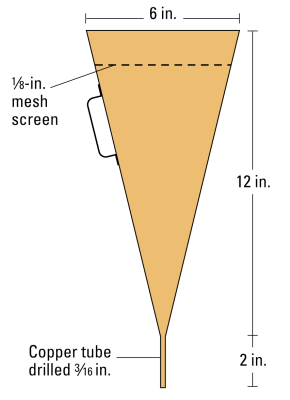1. n. []
A conical-shaped funnel, fitted with a small-bore tube on the bottom end through which mud flows under a gravity head. A screen over the top removes large particles that might plug the tube. In the test standardized by API for evaluating water-base and oil-base muds, the funnel viscosity measurement is the time (in seconds) required for one quart of mud to flow out of a Marsh funnel into a graduated mud cup. Funnel viscosity is reported in seconds (for a quart). Water exits the funnel in about 26 seconds. This test was one of the earliest mud measurements for field use. Simple, quick and fool-proof, it still serves as a useful indicator of change in the mud by comparing mud-in and mud-out sample funnel viscosities.
Hallan N. Marsh of Los Angeles published the design and use of his funnel viscometer in 1931, and it is worth the time to read the detailed, often humorous, discussion that followed. Mr. Marsh was a forward thinking mud technologist in his day, as can be seen from the following words from his 1931 AIME paper: "The subject of mud sounds so simple, uninteresting and unimportant that it has failed to receive the attention that it deserves, at least as applied to the drilling of oil wells. As a matter of fact, it is one of the most complicated, technical, important and interesting subjects in connection with rotary drilling."
Mr. Marsh was quoted by someone who knew him as saying (paraphrased), "Of all the things I have done in mud technology, I am remembered for inventing this d*** funnel."
Reference:
Marsh H: "Properties and Treatment of Rotary Mud," Petroleum Development and Technology, Transactions of the AIME (1931): 234-251.
See related terms: derrickman, funnel viscosity, gel strength, Marsh funnel viscosity, viscosity, viscosity and gel-strength test
